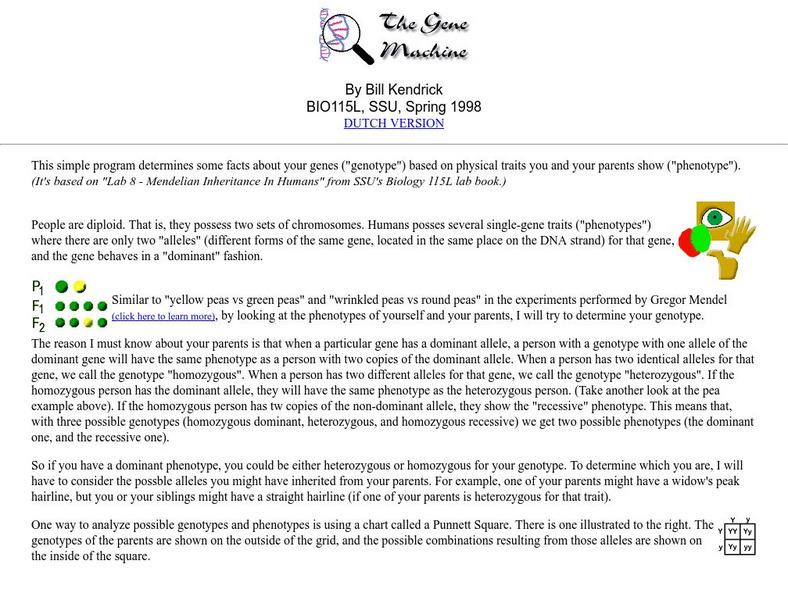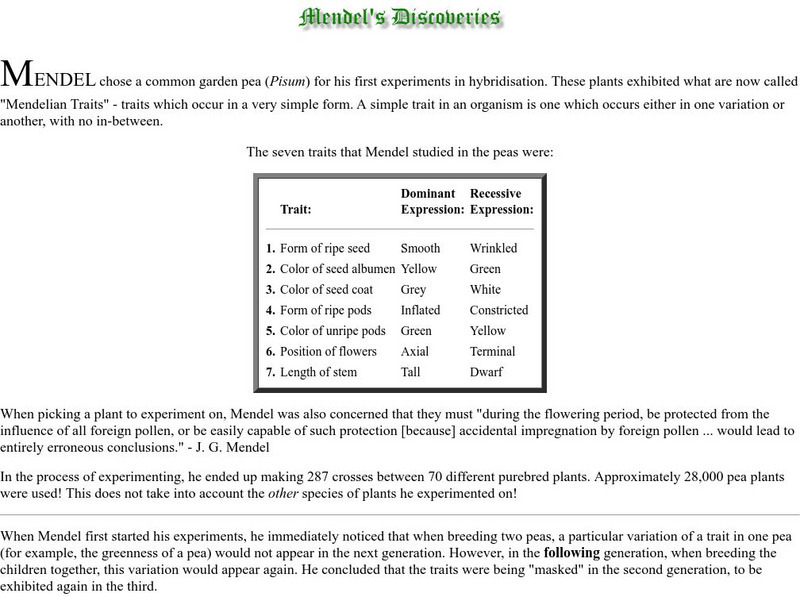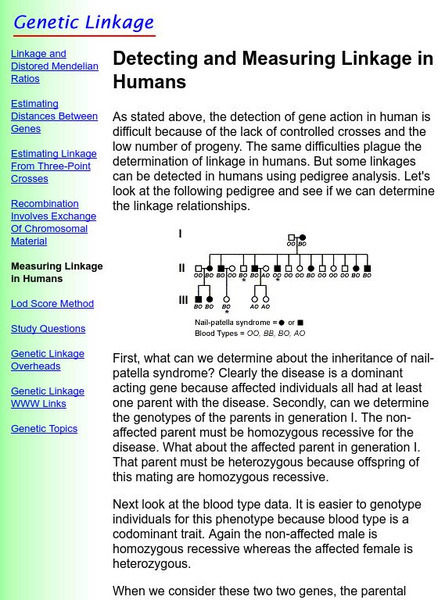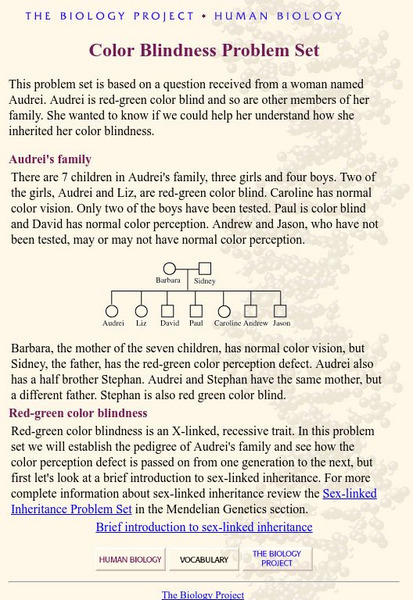CK-12 Foundation
Ck 12: Life Science: Pedigree Analysis
[Free Registration/Login may be required to access all resource tools.] A pedigree is a chart that shows the inheritance of a trait over several generations. A pedigree is commonly created for families, and it outlines the inheritance...
Other
Your Doctor: Sickle Cell Anemia (In Arabic)
Photos of slides and genetics charts accompany the text and explain the differences between sickle cell train vs. sickle cell anemia, symptoms of sickle cell disease, secondary diseases/conditions associated with sickle cell, mechanism...
Other
Biology Project: The Gene Machine
Site allows users to learn interesting information about their genes based on his/her physical traits. Provides a brief explanation of how a person's genotype is determined.
PBS
Pbs Teachers: Scientific American: Never Say Die: How to Make a Nose
Investigate breakthroughs in stem cell research, and explore the structure and function of a DNA molecule. Create a model of a DNA from tagboard.
ArtsNow
Arts Now Learning: Super Gene [Pdf]
In this lesson, 5th graders learn about basic genetics and how genes can affect someone's behavior. They will write their own narrative about a character they create as a class in order to illustrate the effects of inherited traits and...
TED Talks
Ted: Ted Ed: Building a Dinosaur From a Chicken
Renowned paleontologist Jack Horner has spent his career trying to reconstruct a dinosaur. He's found fossils with extraordinarily well-preserved blood vessels and soft tissues, but never intact DNA. So, in a new approach, he's taking...
CK-12 Foundation
Ck 12: Life Science: 3.1 Pea Plants
Understand why Gregor Mendel was the father of the field of genetics, which seeks to explain how traits are passed on from one generation to the next.
Alabama Learning Exchange
Alex: Sponge Bob Round Pants? What's the Chance?
What are the chances of SpongeBob having kids with round pants? Working in cooperative learning groups, young scholars explore the concept of probability. Using interactive websites, students explore the possibilities of an organism...
Sophia Learning
Sophia: Dihybrid Cross: Lesson 2
This lesson will explain how to use a Dihybrid cross when determining multiple genetic traits at once. It is 2 of 4 in the series titled "Dihybrid Cross."
Sophia Learning
Sophia: Dihybrid Cross: Lesson 3
This lesson will explain how to use a Dihybrid cross when determining multiple genetic traits at once. It is 3 of 4 in the series titled "Dihybrid Cross."
Sophia Learning
Sophia: Dihybrid Cross: Lesson 4
This lesson will explain how to use a Dihybrid cross when determining multiple genetic traits at once. It is 4 of 4 in the series titled "Dihybrid Cross."
Sophia Learning
Sophia: Monohybrid Cross: Lesson 3
This lesson will explain how to use a Monohybrid cross when determining genetic traits. It is 3 of 4 in the series titled "Monohybrid Cross."
Sophia Learning
Sophia: Monohybrid Cross: Lesson 4
This lesson will explain how to use a Monohybrid cross when determining genetic traits. It is 4 of 4 in the series titled "Monohybrid Cross."
Other
North Dakota State Univ.: Mendel's Law of Ind. Assort.
Mendel's second law and how he arrived at it through his experiments. Includes vocabulary and examples.
Other
Personal Site / Mendels Discoveries
This personal site gives the seven characteristics that Mendel observed and a fairly large background to what Mendel saw and interpreted.
Other
North Dakota State Univ.: Detecting and Measuring Linkage
A good site to establish what is meant by gene linkage and sex-linkage.
University of Saskatchewan (Canada)
University of Saskatchewan: Multifactorial Inheritance
A short description of multifactorial inheritance as it relates to cattle. This is easy to understand information using a cleft lip and coat color to explain multifactorial inheritance and quantitative inheritance.
University of Arizona
University of Arizona: Dihybrid Problem Set
This site is provided by the University of Arizona and it gives great information on the subject. Good collection of dihybrid crosses which exemplify the issue of independent assortment. Work these once you think you've mastered th concept.
Other
North Dakota State Univ./mendel's Law of Ind. Asstort.
Good description of Mendel's findings and his second major principle.
University of Arizona
The Biology Project: Human Biology: Color Blindness Problem Set
This problem set is based on a question received from a woman with red-green color blind as well as other members of her family. She wanted to know if we could help her understand how she inherited her color blindness.
McGraw Hill
Glencoe Biology: Complex Patterns of Inheritance: Self Check Quiz
A quick, five question multiple-choice quiz assessing complex patterns of human inheritance.
McGraw Hill
Glencoe Biology: Patterns of Human Inheritance: Self Check Quiz
A quick, five question multiple-choice quiz assessing the basic patterns of human inheritance.
Genome British Columbia
Genome British Columbia: Multifactorial Inheritance
A simple explanation of multifactorial inheritance is given followed by a short activity where students do a quiz to assess their possible risk of heart disease.
BioMan Biology
Bio Man Biology: Snurfle Islands
Create a Snurfle and see whether it can survive in different environments. As you play the game, you will learn about natural selection and animal adaptations. At the end of the game, try the multiple-choice quiz to check your...
Other popular searches
- Genetic Traits Chart
- List of Genetic Traits
- Inherit Genetic Traits
- Pedigree Genetic Traits
- Genetic Traits in Families
- Ear Lobe Genetic Traits
- Genetic Traits and Dice
- Genetic Traits Single Gene
- Dna Genetic Traits
- Genetic Traits Hair Whorl
- Genetic Traits Activities
- Passing Genetic Traits






![Arts Now Learning: Super Gene [Pdf] Lesson Plan Arts Now Learning: Super Gene [Pdf] Lesson Plan](https://d15y2dacu3jp90.cloudfront.net/images/attachment_defaults/resource/large/FPO-knovation.png)
















